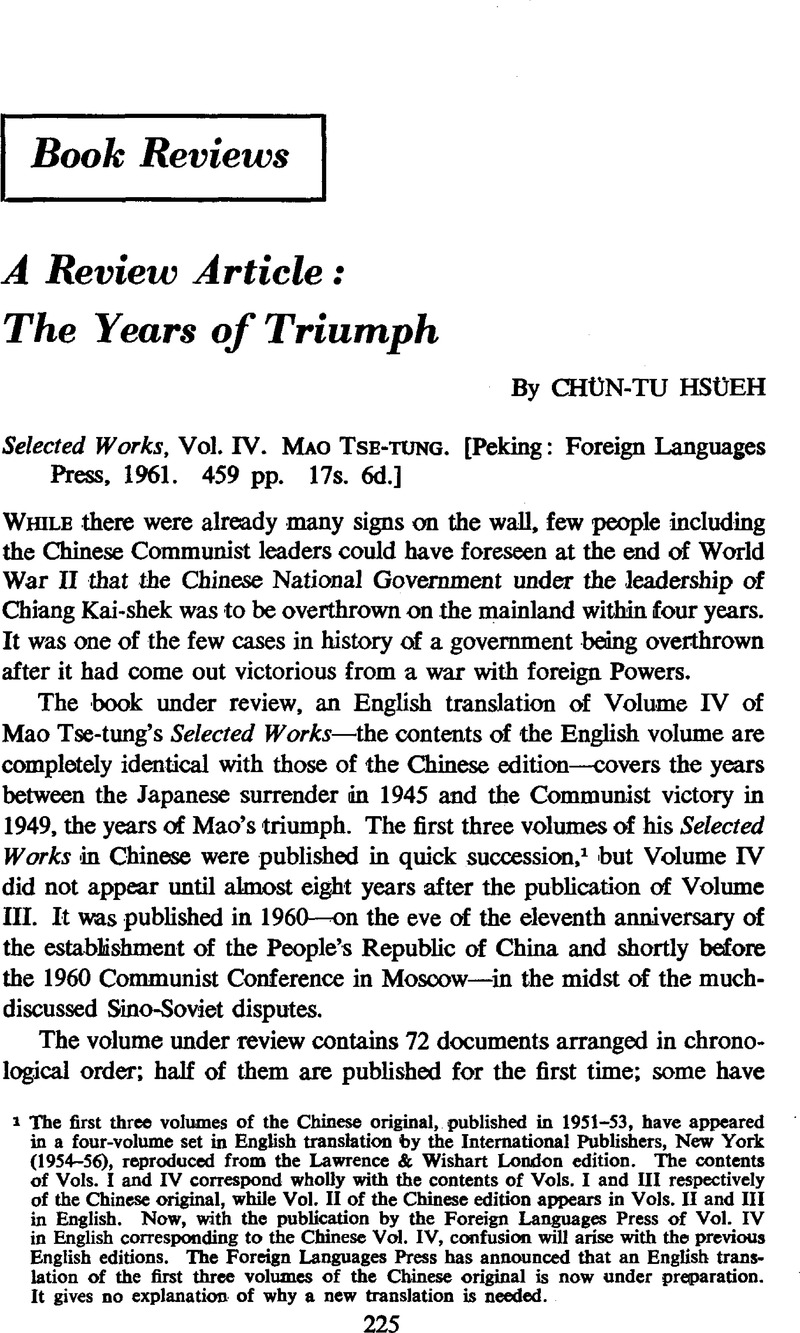No CrossRef data available.
Article contents
A Review Article: The Years of Triumph - Selected Works, Vol. IV. Mao Tse-Tung. [Peking: Foreign Languages Press, 1961. 459 pp. 17s. 6d.]
Published online by Cambridge University Press: 17 February 2009
Abstract

- Type
- Book Reviews
- Information
- Copyright
- Copyright © The China Quarterly 1962
References
1 The first three volumes of the Chinese original, published in 1951–53, have appeared in a four-volume set in English translation by the International Publishers, New York (1954–56), reproduced from the Lawrence & Wishart London edition. The contents of Vols. I and IV correspond wholly with the contents of Vols. I and III respectively of the Chinese original, while Vol. II of the Chinese edition appears in Vols. II and III in English. Now, with the publication by the Foreign Languages Press of Vol. IV in English corresponding to the Chinese Vol. IV, confusion will arise with the previous English editions. The Foreign Languages Press has announced that an English translation of the first three volumes of the Chinese original is now under preparation. It gives no explanation of why a new translation is needed.
2 Two of the seventy titles consist of two documents each. The contents consist of six articles; eight reports and speeches; three statements including two from newspaper interviews; three telegrams sent to Mao's field commander and comrades; three statements issued in the name of the spokesman for the Communist Party of China; eleven commentaries and articles written for, and issued in the name of, the New China News Agency; twenty-two inner-Party circulars drafted for, and issued in the name of the Central Committee of the Party; seven inner-Party and military operation directives drafted for, and sent out in the name of, the Revolutionary Military Commission of the Central Committee of the Party; three military orders, two of them jointly issued with Chu Teh, the Commander-in-Chief of the 18th Group Army; two telegrams written for, and sent out in the name of, Chu Teh; one message written for, and broadcast by, the Headquarters of the Central Plains and the Eastern China People's Liberation Armies; one commentary drafted for, and issued in the name of, the spokesman for the General Headquarters of the Chinese People's Liberation Army; and two political manifestos drafted for, and issued in the name of, the General Headquarters of the Chinese People's Liberation Army.
3 After the Liaohsi-Shenyang Campaign (September 12–November 2, 1948), the whole of the North-East provinces (Manchuria) fell into the Communist hands. With the conclusion of the Huai-Hai Campaign (November 6, 1948–January 10, 1949), Nanking and Shanghai were exposed to direct Communist attack. Meanwhile, the Peiping-Tientsin Campaign (December 5, 1948–January 31, 1949) resulted in the fall of Tientsin on January 15 and the “peaceful liberation” of Peiping (as it was then called) on January 31.


